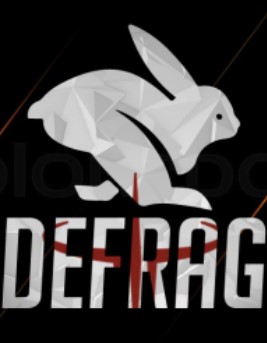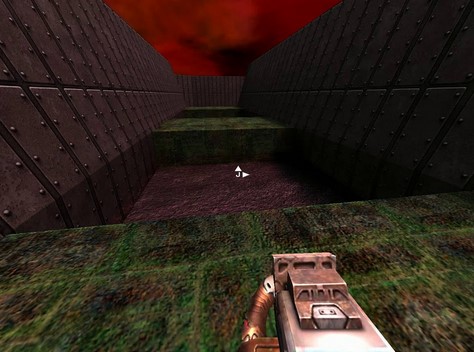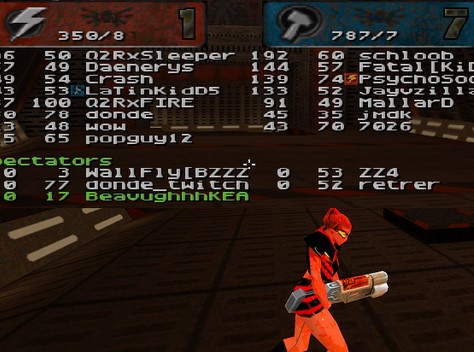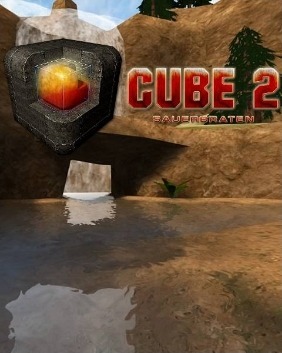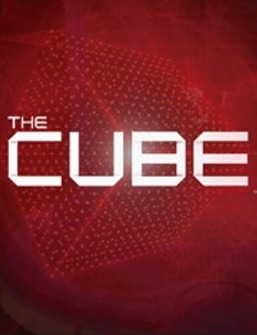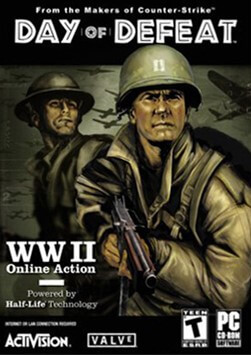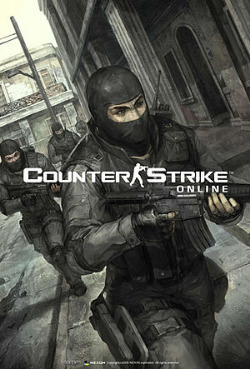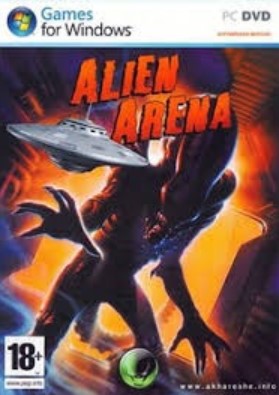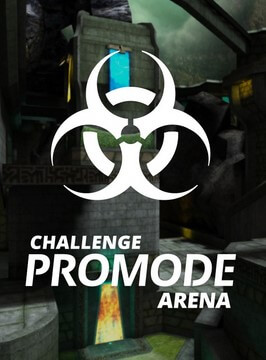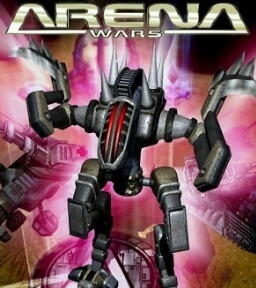DeFRaG (also capitalised as defrag, abbreviated as df, and its name comes from « Défis Fragdome ») is a free software modification for id Software's first-person shooter computer game Quake III Arena (Q3A). The mod is dedicated to player movements and trickjumping.nb It aims at providing a platform for self-training, competition, online tricking, machinima making, and trickjumping. Hence it constitutes an exception among other Q3A mods.
The mod includes a variety of features—timers and meters, ghost mode, cheat prevention and learning tools. Specially designed maps are provided that will rely on the player's movement abilities to be completed up to the finish line, while standard Q3A maps and Capture the Flag (CTF) fast captures are supported as well. Furthermore gamespace physics from both the original Q3A and the Challenge ProMode Arena (CPMA) mod are supported.
The modification was released to the public in ca. September–October 2000. In 2002 DeFRaG was selected as "Mod of the Week" at Planet Quake.
Overview
DeFRaG was initially designed for making possible a new kind of competition based on timed runs. Those competitions called "DeFRaG runs" differ from common speedruns in several ways. Unlike speedruns, DeFRaG runs are not done in maps from an out-of-the-box original game, but in specially designed and customed DeFRaG maps, and there are no opponents to be vanquished during the run. Because of their design many of these maps cannot be completed by normal player skills; rather trickjumping skills are indispensable. Furthermore start-, checkpoints-, and stop-triggers are built into the maps. As a proof of the accomplishment the mod automatically records a demo of every map completed successfully. Along with the demo, the precise time in which the map was completed is stored.
Competition and community
The mod's competitive method is lent to it by an online infrastructure which has triggered the formation of a transnational community. Players download custom-designed maps (more than 6000 DeFRaG maps are available) and aim to complete the map's objectives in the shortest time possible. The best times can be submitted to online high score tables, which are keeping track of the fastest times for particular maps. These online scoreboards can be global or encompass certain regions only. During the mod's highest popularity, the DeFRaG development team periodically released new map packs, containing a number of officially sanctioned maps. These are generally the only maps on which times are accepted for the official website high score tables. In consequence the DeFraG community's individual members engage and specialize in one or more different practices: trickjumping itself, movie making, map making, coding, maintaining websites, portals (for interaction and as archives for maps and movies), and online scoreboards.
Violence
The DeFRaG modification completely removes violence from the otherwise visceral first-person shooter. The gameplay mode or discipline called "deathmatch" came of age with Doom and was also in Q3A, the latter being dedicated to multiplayer competition. From these games electronic sports, and particularly its professional variant emerged. The same games drove the computer games and violence controversy to unprecedented heights. While the Doom series was heavily criticized for its gory content, the problem with Q3A was seen to be its focus on deathmatch, because in this discipline the ultimate objective is to kill ("frag"), as many other players as possible. But in DeFRaG's sic gameplay modes killing opponents has no place whatsoever. DeFRaG gameplay is all about improving the skills to exploit the peculiarities of the Q3A physics in order to move faster, to navigate along courses through the map topographies formerly deemed to be impossible, or to perform moves as yet unseen. In consequence, the in-game weapons are no more regarded as instruments of destruction. Rather DeFRaG players use them as tools for moving around gamespace. This transformation of a first-person shooter into a vehicle for "virtual gymnastics" meanwhile has gradually been recognized by mainstream media. It is thrown into the public discourse as a counterweight to the stereotype of computer games fostering violent behaviour. The DeFRaG mod stars prominently in this.
The high-skill requirement of the game, along with the fast pace, cause that game movies are often made using content created by playing DeFRaG game modes. Within the community's tradition, especially the fastest runs, difficult trickjumping techniques are included in sequence. The DeFRaG demo-playback system includes settings to view the primary player from various angles and perspectives. This is in line with the history of the machinima phenomenon which originates from the speedrun community of Quake, the first game in the series. By following the argumentation of Stanford historian of science and technology Henry Lowood, DeFRaG can be called an instance of transformative high-performance play.
Some of these movies won gaming industry awards. For instance the freestyle trickjumping movie Tricking iT2 by Jethro Brewin "jrb" won five Golden Llamas Awards in 2004. The categories were: Best Picture, Best Audio, Best Tech, Best Editing and Direction, and Best Quake Movie. In the following year the trick-stunt movie Reaching Aural Nirvana by "mrks" won a Golden Llamas Award in the category Best Audio. Also in 2005 the art-house short movie defragged directed by Margit Nobis, an instance of Q3A machinima (its name is borrowed from the DeFRaG mod) was shown at numerous prestigious festivals, including the Vienna Independent Shorts festival.
